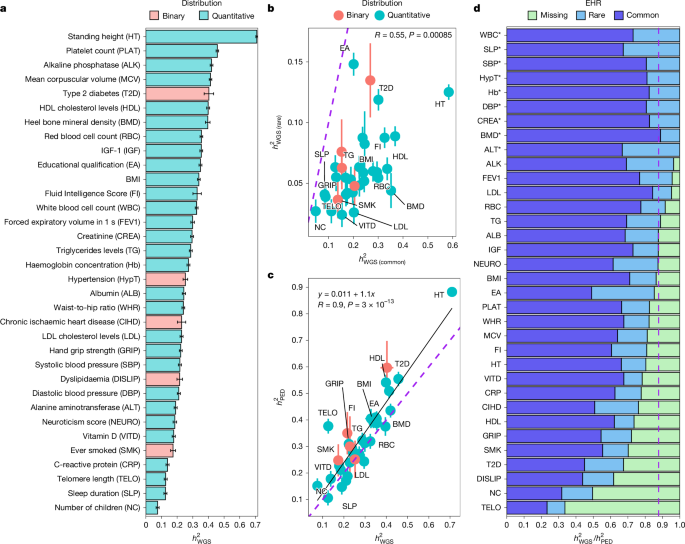
"Most human traits are heritable and influenced by thousands of DNA variants. Whereas the nature and effect size of most causal genetic variants remain largely unknown, previous studies have nonetheless quantified, using a variety of methods, an overall contribution to trait heritability from observable genetic variation4,5,6,7,8. For example, one study9 showed, on average across 1,000 traits, that single-nucleotide polymorphisms (SNPs) that are common in European ancestry populations explain approximately 9% of phenotypic variance, with trait-specific estimates ranging from 5% to 49%."
"The overall proportion of phenotypic variance explained by additive genetic effects of SNPs, also known as SNP-based heritability \(({h}_{{\rm{SNP}}}^{2})\), is a critical parameter that determines the statistical power of genome-wide association studies (GWAS) and provides an upper bound for the performance of trait prediction from genomic data. So far, although GWAS have identified thousands of SNPs associated with many traits and diseases, the amount of phenotypic variance explained by GWAS-detected associations \(({h}_{{\rm{GWAS}}}^{2})\) remains, for most traits, substantially lower than \({h}_{{\rm{SNP}}}^{2}\)."
Most human traits are heritable and influenced by thousands of DNA variants. Common SNPs in European-ancestry populations explain approximately 9% of phenotypic variance on average, with trait-specific estimates from 5% to 49%. SNP-based heritability (h_SNP^2) represents the proportion of variance explained by additive genetic effects of SNPs and constrains GWAS power and genomic prediction. GWAS have discovered thousands of associated SNPs, but the variance explained by GWAS-detected associations (h_GWAS^2) is typically much lower than h_SNP^2. The gap between h_GWAS^2 and h_SNP^2, termed "hiding heritability," is expected to diminish as GWAS sample sizes grow, as demonstrated by a height GWAS of over five million individuals.
Read at Nature
Unable to calculate read time
Collection
[
|
...
]